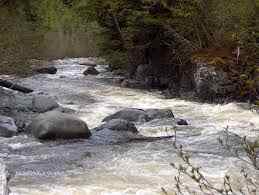Long Range Fish Report
From Sportfishing
From Sportfishing
Fish Report for 8-15-2013
Regarding Callibaetis
8-15-2013
SportfishingReport.com Staff
By John Juracek
While looking through some caddisfly identification keys the other day, I happened across some notes I'd jotted down years ago regarding the developmental cycles of mayflies. The notes were from a paper written by Vladimir Landa titled Developmental Cycles Of Central European Ephemeroptera And Their Interrelationships, published in the journal Acta entomologica Bohemoslovaca. Finding these notes piqued my interest because one of them referred to Callibaetis mayflies. August is a prime time for Callibaetis emergences on area lakes like Hebgen and Quake in Montana.
Landa described a series of developmental cycles of mayflies, one of which generally fits our experiences with Callibaetis on Hebgen Lake. In his proposed "type B3" cycle, first generation eggs hatch in autumn. The nymphs from these eggs mature over the winter and hatch the following spring. Two other generations then develop in quick succession in the summer. On Hebgen, Callibaetis begin emerging in late May and continue for several weeks. These Callibaetis are roughly a size #14. A brief lull then occurs until mid-July, at which point a new generation appears (or so it seems; the flies are now size #16). This second generation is by far the strongest in number, lasting through most of August. Towards the end of August a third generation appears, now size #18. Typically, this third generation isn't as numerous as the second, and its emergence cycle ends around mid-September.
Landa also notes that shifts can occur in this cycle as temperatures and altitude changes. I think we see this on Hebgen. The Grayling arm, the Madison arm, the South Fork arm and the main body of the lake all have different temperature regimes, and the timing and duration of the Callibaetis cycles varies with each location. The net effect of this is that Callibaetis hatches can be found on Hebgen from late May until the middle of September. That makes it the longest running hatch in the entire Yellowstone area. (There was a time when entomologists proposed that two species of Callibaetis resided in Hebgen, which would also explain such a long-running emergence. Current taxonomy suggests that only one species--ferrugineus hageni--is found there. But as entomology is such an ever-changing field, I think on this matter the jury is still out.)
In any event, if you're looking for reliable dry fly activity in August, especially during the morning hours, think Callibaetis. Besides Hebgen and Quake lakes, you'll find them hatching on Island Park Reservoir, Elk Lake, Hidden Lake and Ennis Lake.
John
While looking through some caddisfly identification keys the other day, I happened across some notes I'd jotted down years ago regarding the developmental cycles of mayflies. The notes were from a paper written by Vladimir Landa titled Developmental Cycles Of Central European Ephemeroptera And Their Interrelationships, published in the journal Acta entomologica Bohemoslovaca. Finding these notes piqued my interest because one of them referred to Callibaetis mayflies. August is a prime time for Callibaetis emergences on area lakes like Hebgen and Quake in Montana.
Landa described a series of developmental cycles of mayflies, one of which generally fits our experiences with Callibaetis on Hebgen Lake. In his proposed "type B3" cycle, first generation eggs hatch in autumn. The nymphs from these eggs mature over the winter and hatch the following spring. Two other generations then develop in quick succession in the summer. On Hebgen, Callibaetis begin emerging in late May and continue for several weeks. These Callibaetis are roughly a size #14. A brief lull then occurs until mid-July, at which point a new generation appears (or so it seems; the flies are now size #16). This second generation is by far the strongest in number, lasting through most of August. Towards the end of August a third generation appears, now size #18. Typically, this third generation isn't as numerous as the second, and its emergence cycle ends around mid-September.
Landa also notes that shifts can occur in this cycle as temperatures and altitude changes. I think we see this on Hebgen. The Grayling arm, the Madison arm, the South Fork arm and the main body of the lake all have different temperature regimes, and the timing and duration of the Callibaetis cycles varies with each location. The net effect of this is that Callibaetis hatches can be found on Hebgen from late May until the middle of September. That makes it the longest running hatch in the entire Yellowstone area. (There was a time when entomologists proposed that two species of Callibaetis resided in Hebgen, which would also explain such a long-running emergence. Current taxonomy suggests that only one species--ferrugineus hageni--is found there. But as entomology is such an ever-changing field, I think on this matter the jury is still out.)
In any event, if you're looking for reliable dry fly activity in August, especially during the morning hours, think Callibaetis. Besides Hebgen and Quake lakes, you'll find them hatching on Island Park Reservoir, Elk Lake, Hidden Lake and Ennis Lake.
John
< Previous Report Next Report >
More Reports
Sportfishingreport.com Reports
for Thursday, August 15th, 2013
Trinity River: Judge halts Klamath River flows, for now; order on salmon releases in effect through Friday
• How does a tournament Bass professional outfit his boat?
• Bass Fishing Hook Set Basics
• This is what fly fishing is all about
• Hunting season is just around the corner, here is a video on shotgun patterning for waterfowl huntin
• Dry Fly & Sight Fishing Steelhead & Salmon in British Columbia
Sportfishingreport.com Reports
for Wednesday, August 14th, 2013
Lake Casitas: John's Fishing Channel goes bass fishing with Rich Tauber
Shasta Lake: Public Shows Overwhelming Opposition to Shasta Dam Raise at Workshop

LongRangeSportfishing.net © 2025. All Rights Reserved.
Website Hosting and Design provided by TECK.net
Website Hosting and Design provided by TECK.net